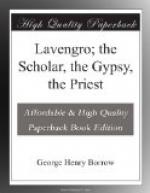Nobody has, so far, attempted to write the life of George Borrow. Nor can we wonder. How could any one dare to follow in the phosphorescent track of Lavengro and The Romany Rye, or add a line or a hue to the portraits there contained of Borrow’s father and mother—the gallant soldier who had no chance, and whose most famous engagement took place, not in Flanders, or in Egypt, or on the banks of the Indus or Oxus, but in Hyde Park, his foe being Big Ben Brain; and the dame of the oval face, olive complexion, and Grecian forehead, sitting in the dusky parlour in the solitary house at the end of the retired court shaded by lofty poplars? I pity ‘the individual’ whose task it should be to travel along the enchanted wake either of Lavengro in England or Don Jorge in Spain. Poor would be his part; no better than that of Arthur in ’The Bothie’:—
And it was told, the Piper narrating
and Arthur correcting,
Colouring he, dilating, magniloquent,
glorying in picture,
He to a matter-of-fact still softening,
paring, abating,
He to the great might-have-been
upsoaring, sublime and ideal,
He to the merest it-was restricting,
diminishing, dwarfing,
River to streamlet reducing, and
fall to slope subduing:
So it was told, the Piper narrating,
corrected of Arthur.
George Borrow, like many another great man, was born in Norfolk, at East Dereham, in 1803, and at an early age began those rambles he has made famous, being carried about by his father, Captain Borrow, who was chiefly employed as a recruiting officer. The reader of Lavengro may safely be left to make out his own itinerary. Whilst in Edinburgh Borrow attended the High School, and acquired the Scottish accent. It is not too much to say that he has managed to make even Edinburgh more romantic simply by abiding there for a season. From Scotland he went to Ireland, and learnt to ride, as well as to talk the Irish tongue, and to seek etymologies wherever they were or were not to be found. But for a famous Irish cob, whose hoofs still sound in our ears, Borrow, so he says, might have become a mere philologist. From Ireland he returned with his parents to Norwich, and resumed studies, which must have been, from a schoolmaster’s point of view, grievously interrupted, under the Rev. Edward Valpy at King Edward’s School. Here he seems to have been for two or three years. Dr. Jessopp has told us the story of Borrow’s dyeing his face with walnut juice, and Valpy gravely inquiring of him, ’Borrow, are you suffering from jaundice, or is it only dirt?’ The Rajah of Sarawak, Sir Archdale Wilson, and the Rev. James Martineau were at school with ‘Lavengro.’ Dr. Jessopp, who in 1859 became headmaster of King Edward’s School, and who has been a Borrovian from the beginning, found the school tradition to be that Borrow, who never reached the sixth form, was indolent and even stupid. In 1819,—the reader will be




